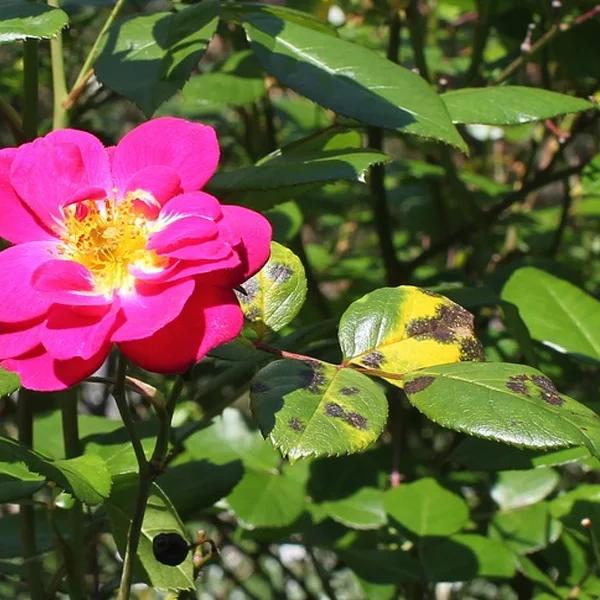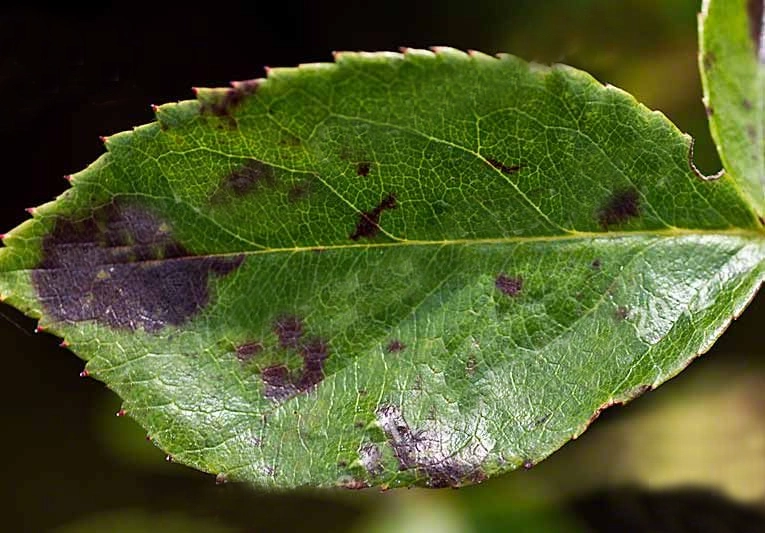Table of Contents
What are these black spots and yellow patches on my rose’s leaves?
Black spots on rose leaves, usually surrounded by yellowing areas, are caused by the fungus Diplocarpon rosae, the most widespread and serious fungal disease affecting members of the rose family.
Black Spot spores lie dormant in the soil over Winter, then rise up and attack from Spring onwards.
Black Spot has become worse in recent decades as the air in the UK has become cleaner, specifically with less Sulphur pollution, which is a natural fungicide.
How Bad is Black Spot?
A bad case of Rose Black Spot can defoliate a bush completely, ruining its appearance and eventually killing it because it can’t photosynthesize.
Your rose won’t die in the first or the second year, but without your assistance it can die after three or four years of constant infection.
But that is not too common. In the vast majority of cases, black spot is just something you live with.
Rose Black Spot Symptoms
Watch out for the signs of black spot attack from April to September-October.
- The main Black Spot symptom is black splotches on the upper surface of the leaf. These might spread rapidly or slowly.
- The leaf around the black spots usually, but not always, turns yellow.
- The affected leaf usually, but not always, falls off before Autumn.


How to Treat Rose Black Spot
Wherever there are Roses, there will be Rose Black Spot spores. The way forward is to practise good garden hygiene.
Black Spot strains evolve quickly, which means new Black Spot resistant varieties often lose their immunity within a few years, sometimes to the point that they are no longer grown and sold.
Non-Chemical Control
- Collect and burn or bin fallen leaves in the autumn. We do not recommend covering them with mulch: it’s probably better than doing nothing, but any disturbance allows the spores to rise the following Spring.
- Cut out any affected stems before the young foliage appears in spring.
- Improve the soil. There are few better things a gardener can do than increase the organic content of the soil. The more moisture and nutrient the ground provides the stronger and less stressed the plants that grow in it. Strong plants tend to stay healthy.
- Don’t plant rose bushes where there is restricted air movement and prune them, so they have a nice open shape.
Top Tip: If you have one rose with black spot, while others in your garden and neighbouring gardens are reasonably disease free, then the obvious, easy move is simply to get rid of it!
Remember the usual precautions against rose replant disease if you want to replace it with another rose.
Chemical Control
There are a range of fungicides like Uncle Tom’s Rose Tonic that attack and prevent Black Spot. The rules about fungicides change fast, and so the chemicals available change as well.
We recommend using different products that use different chemicals on rotation to prevent a build up of resistance.
Black Spot Disease Resistant Rose Varieties
Many popular patio, floribunda, hybrid tea, and climbing roses are prone to Black Spot, but modern breeding programs are gradually producing more resistant varieties.
Most shrub roses, especially the oldest varieties like Rosa mundi / versicolor, ramblers, and wild rose species are pretty immune to disease.
These are some of the most disease resistant, modern rose varieties recommended by the RHS:
- Flower Carpet Series: There are 11 colours in the range, we grow Pink, Ruby, Scarlet, and Yellow.
- ‘Ballerina’, Pink Shrub
- ‘Buff Beauty’, Apricot-Yellow Shrub
- ‘Lucky’ Pink Floribunda
- ‘Silver Anniversary’ Hybrid Tea
